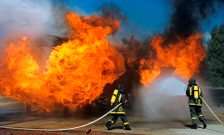Robots on reins could be the 'eyes' of firefighters

Researchers at King's College London have developed revolutionary reins that enable robots to act like guide dogs, which could enable that firefighters moving through smoke-filled buildings could save vital seconds and find it easier to identify objects and obstacles.
The small mobile robot – equipped with tactile sensors – would lead the way, with the firefighter following a metre or so behind holding a rein. The robot would help the firefighter move swiftly in 'blind' conditions, while vibrations sent back through the rein would provide data about the size, shape and even the stiffness of any object the robot finds.
This potentially life-saving application of robotics has been developed by scientists at King's and Sheffield Hallam University, with funding from the Engineering and Physical Sciences Research Council (EPSRC).
Dr Thrish Nanayakkara, Department of Informatics at King's, said: 'We've made important advances in understanding robot-human interactions and applied these to a classic life-or-death emergency scenario where literally every second counts. Robots on reins could add an invaluable extra dimension to firefighting capabilities.'
Project partners have included the charity Guide Dogs, South Yorkshire Fire & Rescue Service and Thales Ltd. Now proof of concept has been completed, the team plan to build a full working prototype for testing in real-world firefighting conditions.
The team has developed a visual language for using robotics in a number of domestic scenarios and now plans to explore how Reins and haptic signals could help older people in their homes.
Currently, even when they have a map of the building, firefighters have to grope their way forward if smoke has badly affected visibility, feeling their way along a wall or following ropes laid by the first firefighter on the scene. But with only 20 minutes of oxygen per firefighter, there's a real need for any innovation that can help them move more quickly and easily.
With the new system, the firefighter would wear a special sleeve covering their entire arm and incorporating electronic micro-vibrators that turn the signals sent back by the robot into detailed data that the firefighter would have been trained to interpret.
The robot would also sense any hesitation or resistance from the firefighter and adjust its pace accordingly. In addition, it would be programmed to predict the follower's next actions, based on the way they are moving as well as on their previous actions. In trials, blindfolded volunteers were guided by a robot. By using an algorithm the robot could detect the fire-fighters level of trust.
Jacques Penders, Sheffield Hallam University, added: 'EPSRC support has enabled us to undertake a real breadth of research and given us the scope to explore a range of approaches for human-robot interaction in no-visibility conditions that we simply couldn't have looked at with other forms of funding. The outcome has been exciting and not only could help our world-class firefighting services become even more effective in future but may also find application in healthcare, for instance.'
Provided by King's College London





















